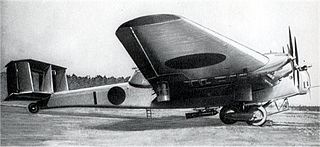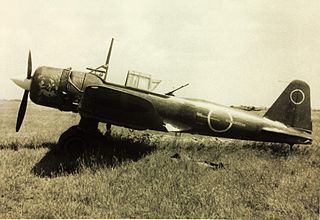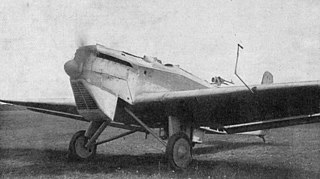
The Mitsubishi A5M, formal Japanese Navy designation Mitsubishi Navy Type 96 Carrier-based Fighter (九六式艦上戦闘機), experimental Navy designation Mitsubishi Navy Experimental 9-Shi Carrier Fighter, company designation Mitsubishi Ka-14, was a Japanese carrier-based fighter aircraft. It was the world's first low-wing monoplane shipboard fighter to enter service and the predecessor to the famous Mitsubishi A6M "Zero". The Allied reporting name was Claude.

The Mitsubishi Ki-46 was a twin-engine reconnaissance aircraft used by the Imperial Japanese Army in World War II. Its Army Shiki designation was Type 100 Command Reconnaissance Aircraft (一〇〇式司令部偵察機); the Allied brevity code name was "Dinah".

The Mitsubishi Ki-67Hiryū was a twin-engine heavy bomber produced by Mitsubishi and used by the Imperial Japanese Army Air Service and Imperial Japanese Navy Air Service in World War II. Its Army long designation was "Army Type 4 Heavy Bomber" (四式重爆撃機). Japanese Navy variants included the P2M and Q2M.

The Kawasaki Ki-45 Toryu was a two-seat, twin-engine heavy fighter used by the Imperial Japanese Army in World War II. The army gave it the designation "Type 2 Two-Seat Fighter"; the Allied reporting name was "Nick". Originally serving as a long-range escort-fighter, the design — as with most heavy fighters of the period — fell prey to smaller, lighter, more agile single-engine fighters. As such, the Ki-45 instead served as a day and nighttime interceptor and strike-fighter.

The Mitsubishi Ki-20 is a Japanese bomber variant of the Junkers G.38 airliner. Mitsubishi manufactured six aircraft under license from Junkers. These aircraft, designated Army Type 92 Heavy Bomber, served through the 1930s. During World War II, the Ki-20 served in a variety of transport and support roles.

The Mitsubishi Ki-51 was a light bomber/dive bomber in service with the Imperial Japanese Army during World War II. It first flew in mid-1939. Initially deployed against Chinese forces, it proved to be too slow to hold up against the fighter aircraft of the other Allied powers. However, it performed a useful ground-attack role in the China-Burma-India theater, notably from airfields too rough for many other aircraft. As the war drew to a close, the Japanese began using them in kamikaze attacks. Total production was around 2,385 units.

The Mitsubishi B1M was a Japanese torpedo bomber of the 1920s, also known as the Navy Type 13 Carrier-Borne Attack Aircraft. It was designed and built by Mitsubishi and used in combat against China. The aircraft was used by the air services of the Imperial Japanese Navy and Imperial Japanese Army.

Junkers A 35 was a two-seater cantilever monoplane, used for postal, training and military purposes. The aircraft was designed in the 1920s by Junkers in Germany and manufactured at Dessau and by AB Flygindustri in Limhamn, Sweden and conversions from A 20s were made in Fili, Russia.

The Junkers G 24 was a German three-engine, all-metal low-wing monoplane passenger aircraft manufactured by Junkers from 1925. Junkers F 24 was the designation for single-engine versions of the same aircraft.

The Nakajima Ki-49Donryu was a twin-engine Japanese World War II heavy bomber. It was designed to carry out daylight bombing missions, without the protection of escort fighters. Consequently, while its official designation, Army Type 100 Heavy Bomber, was accurate in regard to its formidable defensive armament and armor, these features restricted the Ki-49 to payloads comparable to those of lighter medium bombers – the initial production variant could carry only 1,000 kg (2,200 lb) of bombs.

The Mitsubishi Ki-30 was a Japanese light bomber of World War II. It was a single-engine, mid-wing, cantilever monoplane of stressed-skin construction with a fixed tailwheel undercarriage and a long transparent cockpit canopy. The type had significance in being the first Japanese aircraft to be powered by a modern two-row radial engine. During the war, it was known by the Allies by the name Ann.
The PZL.48 Lampart (leopard) was a Polish heavy fighter-bomber design, that remained only a project, owing to the outbreak of World War II.

The Mitsubishi Ki-83 (キ83) was a Japanese experimental long range heavy fighter designed near the end of World War II. It did not reach production status.

The Mitsubishi Ki-1, also known as Mitsubishi Army Type 93 Heavy Bomber, was a bomber built by Mitsubishi for the Imperial Japanese Army in the 1930s. The Ki-1 design was heavily based on the Junkers K 37 and a mockup was ready in August 1932, with the first prototype being finished in March 1933.

The Mitsubishi Ki-2 was a light bomber built by Mitsubishi for the Imperial Japanese Army Air Service (IJAAS) in the 1930s. Its Allied nickname was "Louise". Despite its antiquated appearance, the Ki-2 was successfully used in Manchukuo and in North China during the early stages of the Second Sino-Japanese War, in areas where danger from enemy fighter aircraft was minimal. It was later used in a training role.
The Nakajima Ki-19 was an unsuccessful attempt by Nakajima Aircraft Company to meet a 1935 requirement issued by the Japanese government for a modern bomber to replace the Mitsubishi Ki-1 heavy bomber.

The Junkers A 32 was a mail plane built in prototype form in Germany in the late 1920s, and later developed as a prototype reconnaissance-bomber under the designation K 39. The design was a conventional low-wing cantilever monoplane with fixed tailskid undercarriage. Construction was metal throughout, with corrugated duralumin skin. Three open cockpits were provided in tandem; the third seat intended from the outset to accommodate a tail gunner for a military version of the aircraft. In fact, the militarised version developed in Sweden by AB Flygindustri featured a fourth crew position as well, for a bombardier. This version featured twin machine guns built into the engine cowling, and a trainable machine gun for the tail gunner.

The Rikugun Ki-93 was a prototype Japanese twin-engined fighter aircraft of the Second World War. Designed by the Army Aerotechnical Research Institute, to be a heavy fighter armed with large calibre cannon to serve in the anti-shipping or bomber destroyer roles, only one example of the Ki-93 was completed; this was damaged on its maiden flight, and destroyed by American bombing before it could be flown again.
The Mansyū Ki-98,, was a Japanese ground-attack aircraft proposed by Mansyū during World War II for use by the Imperial Japanese Army Air Force. The still unassembled components of the first prototype were deliberately destroyed before Japan surrendered.
The Dornier Do 417 was a twin-engine multirole bomber. Developed in 1942, it emerged from the Luftwaffe's request for a medium bomber, a contest for which Dornier, Junkers, Heinkel, and Blohm & Voss competed. In the end, the Junkers Ju 188 was chosen, and the Do 417 was never entered production.


















